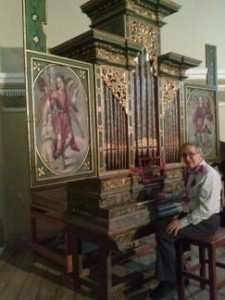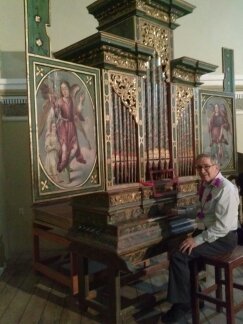
I had the good fortune to attend this roughly biennial event organized by the Instituto de Órganos Históricos de Oaxaca under the direction of Cicely Winter, long-time advocate for early organ culture in this picturesque and ancient state of southwestern Mexico. The first such festival in 2001 celebrated the restoration of six organs dating to the early 17th century with concerts, lectures and tours of important archeological sites. This year’s event followed a similar course with concerts on eight restored organs, highlighted by a festive high mass, concert and fiesta to celebrate the just completed restoration of the organ at the Templo de Santa María de la Asunción, Tlacolula, built in 1791 by Manuel Neri y Carmona.
Many of the organs in Oaxaca are based on 4’ tone. While this may seem a severe limitation, given the generous acoustics of the large, stone churches and the placement of the organs high in a rear or side gallery, the amount and quality of tone generated by these instruments is quite sufficient to support congregational singing and to perform much of the early Spanish literature, which is their heritage.
As with most organs in early Spanish style, the single keyboard (without pedals) is divided at middle C, enabling performance of music with contrasting registrations. Most of the instruments are tuned in period temperaments, often ¼-comma meantone, at pitch levels ranging from A 392 to A 440, many tuned to A 415. In additional to the colorful stops available—few mixtures but a wide variety of reeds, including horizontal Clarínes and Trompetas—the exteriors of the organ cases without exception testify to the builders’ keen interest in the visual presentation of the organ, complementing the astounding richness of the paintings, sculpture, retablos and elaborate masonry of the churches themselves.
The organ cases are decorated with intricate wood carvings, sometimes gilt, or with panels painted to represent saints and bear a unique profile found only in Oaxaca: the presence of so-called hips, non-functional bulges on either side of the case just below the impost. Often the pipes in the façade bear painted faces, religious figures or common folk, with the mouth of each pipe serving a pictorial and functional duty. For those in the San Francisco Bay Area, a good representation of this sort of organ can be found at the Mission San Jose, Fremont, where a Mexican Colonial period style instrument by Los Angeles builder Manuel Rosales resides. Shortly after the Spanish conquest of Mexico, organs were increasingly built by indigenous inhabitants, as were the impressive church edifices.
While the eight concerts focused on 16th and 17th century repertoire, mostly Spanish, one heard early but also later music by other composers from Europe and from Mexico itself, and not always on the organ. Occasionally a vocalist or choir was supported by the organ, and on a few occasions, youthful performers on the vibraphone, marimba and an excellent trio of guitarists added variety to the programs.
I was privileged to perform in a concert on the small 1726 organ at San Andrés Zautla together with a number of other organists, which despite its diminutive size and hand pumped wind supply, amply filled the sizeable church with its noble, ancient sonorities.
At each site visited during the festival, commentary on the culture, history and art of the churches and the region was supplied by archeologists and travel guide authors accompanying the tour buses. Many participants were not musicians but rather enthusiastic visitors as well as local residents, taking advantage of this well-planned, unique exploration of one of Mexico’s economically poorer but culturally rich states.
Most impressive to me was the support of the government of Mexico, private donors and the local citizenry for what they describe as their patrimony, their cultural heritage. Cicely Winter told me that many organs in Oaxaca remain unrestored because of their remote locations, the lack of extant material, or the unlikelihood of the organ ever being played. But it is never the case that funding for restoration is an issue, due to the generous support of private patrons and institutions and the encouragement of the Mexican government.
The first day of the Festival included a gala reception at which a set of postal stamps in honor of the festival were presented with a special first day cancellation. Throughout the week it was obvious that even the small towns in which concerts were given showed enormous appreciation for the organ as an artifact of their civic and cultural pride. Every performance was filled to capacity far exceeding the 100 or so official attendees of the Festival. Village churches seating 500 had listeners, young and old, standing in the aisles, while outside loud fireworks could be heard mostly before and after concerts. At the nearly two-hour-long high mass in Tlacolula, population ca. 30,000, celebrating the newly restored organ, a community choir from Oaxaca sang while the Archbishop of Oaxaca presided and delivered a lengthy but attentively appreciated homily on community spirit.
Perhaps the most encouraging aspect of the Festival was the participation by about a dozen young Mexican organists and musicians, one in high school, most in college, who attended every event, helping out with logistics and performing as well. It was a very busy schedule, culturally enriching, and a great opportunity to enjoy the hospitality and always helpful people of a region known as a tourist destination and now appreciated as well for its music.
